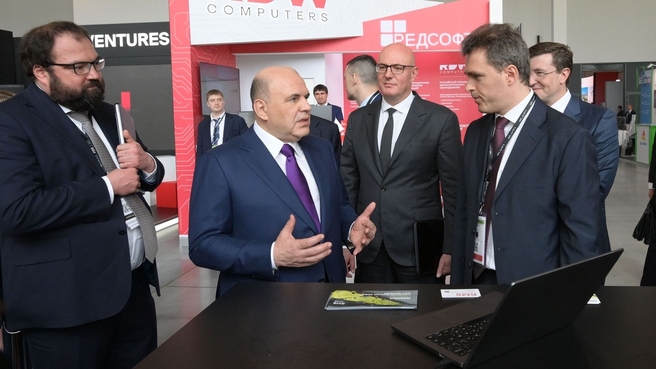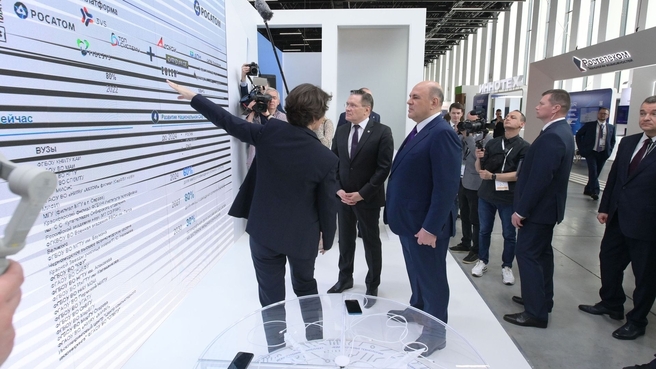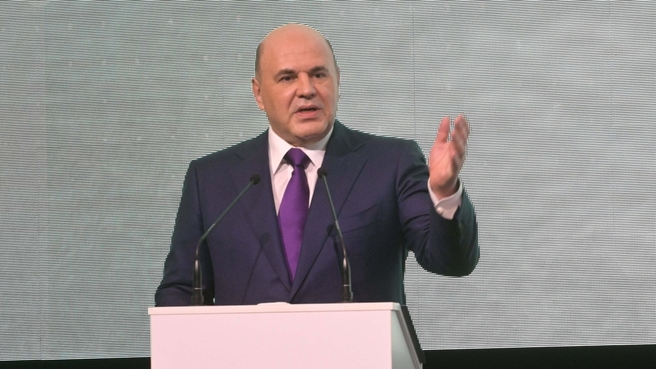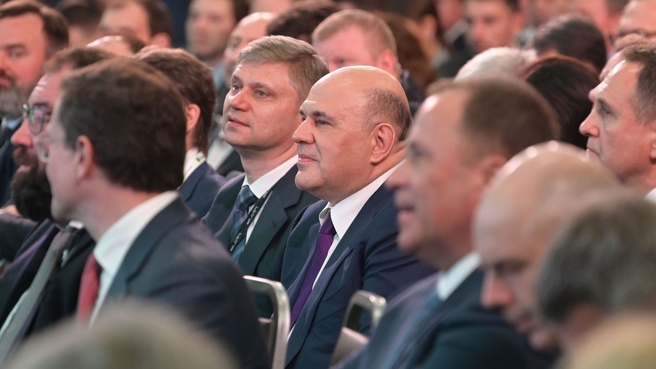The Prime Minister toured the CIPR-2022 exhibition and took part in a plenary session.
Mikhail Mishustin’s opening remarks at the 7th Digital Industry of Industrial Russia conference:
Good afternoon, friends.
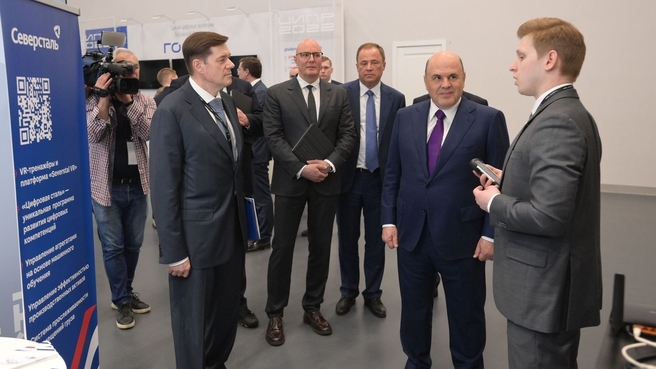
Mikhail Mishustin at the CIPR-2022 exhibition with Dmitry Chernyshenko, Presidential Plenipotentiary Envoy to the Volga Federal District Igor Komarov, Chairman of Severstal Board of Directors Alexei Mordashov and chief of the strategic development department of Severstal-Infokom Sergei Kolbasov
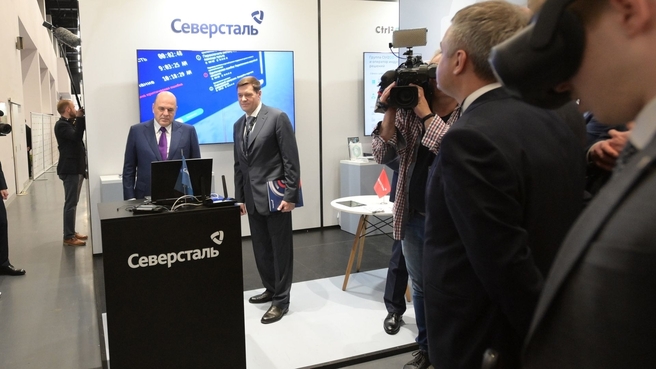
Mikhail Mishustin at the CIPR-2022 exhibition with Chairman of Severstal Board of Directors Alexei Mordashov
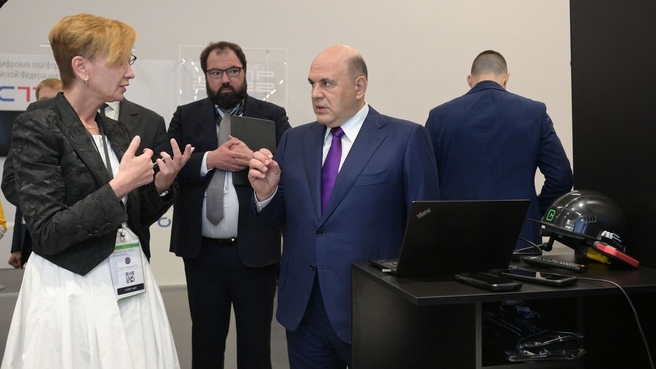
Mikhail Mishustin at the CIPR-2022 exhibition with Minister of Digital Development, Communications and Mass Media Maksut Shadayev and SIBUR DIGITAL General Director Alisa Melnikova
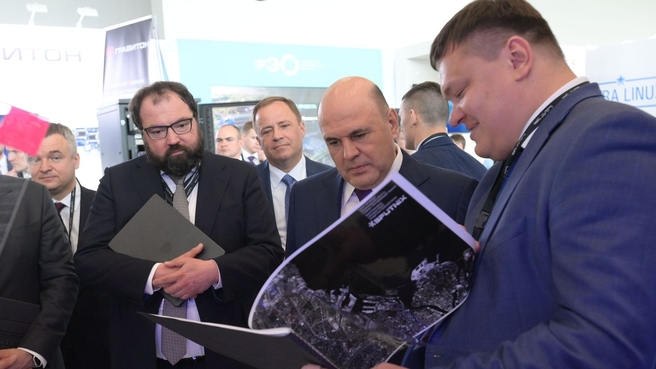
Mikhail Mishustin at the CIPR-2022 exhibition with Minister of Digital Development, Communications and Mass Media Maksut Shadayev, Presidential Plenipotentiary Envoy to the Volga Federal District Igor Komarov and President of Sitronics Nikolai Pozhidayev
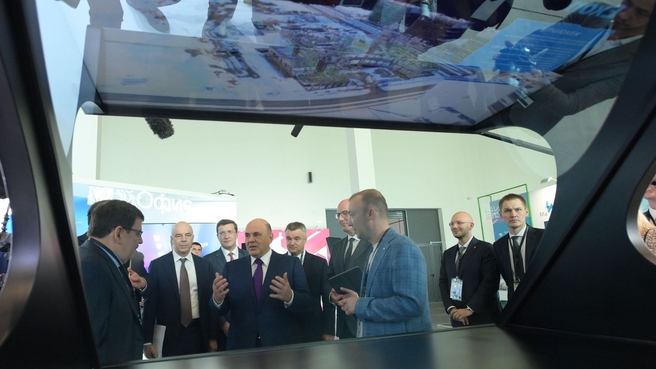
Mikhail Mishustin at the CIPR-2022 exhibition with Dmitry Chernyshenko, Governor of the Nizhny Novgorod Region Gleb Nikitin, Minister of Finances Anton Siluanov and Deputy Minister of Industry and Trade Vasily Shpak
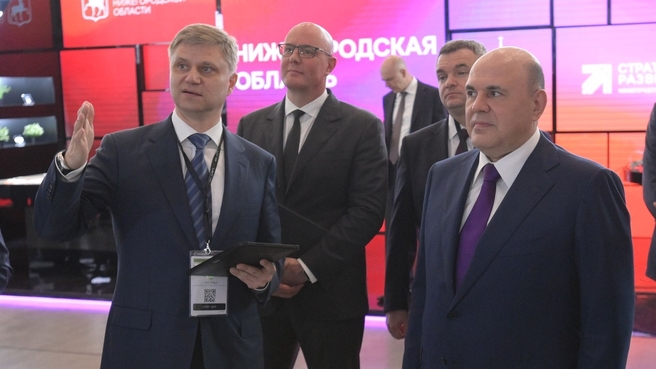
Mikhail Mishustin at the CIPR-2022 exhibition with Dmitry Chernyshenko and Chairman of the Board of Russian Railways Oleg Belozyorov
Mikhail Mishustin at the CIPR-2022 exhibition with Dmitry Chernyshenko, Presidential Plenipotentiary Envoy to the Volga Federal District Igor Komarov, Chairman of Severstal Board of Directors Alexei Mordashov and chief of the strategic development department of Severstal-Infokom Sergei Kolbasov
I’m delighted to welcome the participants of the Digital Industry of Industrial Russia conference, which is an important event that brings together government officials, industrialists, experts and our scientific community, and also gives us all a chance to exchange best practices and ideas and to present advanced projects.
The President identified digital transformation as one of the most important national development goals. This year, with the Nizhny Novgorod Region government, we re-launched the conference format, changed its logic and combined the exposition and business programme with key industries that are our economic drivers. We will work to ensure their digital maturity, which we have covered extensively.
We are working in the new environment of sanctions imposed on Russia by unfriendly states.
Restrictions on the supply of critically important goods confirmed that our course of developing domestic high-tech production was the right one.
That said, we need to promptly take additional measures to increase the competitiveness of Russian companies and their products. This can be achieved through the best available domestic technologies, primarily, digital technologies. Our IT sector must become a service platform for Russian industry, which will help us take it to a higher level. We covered this in detail with the participants of the exhibition which is, by the way, an excellent exhibition.
The rapid restructuring of basic and high-tech industries in the current circumstances is possible only with the combined efforts of customers and developers. We need to develop innovative tools to increase productivity and efficiency, which all industrialists are well aware of, and to pursue a personnel policy that will help realise the talents of our engineers, designers and process engineers.
It is important to restore the role of the manufacturing industry as the national economy’s basic component.
We must reduce dependence on imports and launch our own innovative projects to develop, manufacture and test our products which will be using end-to-end robotics, AI, cybersecurity, big data, wireless communications and the IoT technology at all stages of the life cycle.
To do so, it is necessary to build a well-performing and modern industrial management system, to approve appropriate industry standards, to support our enterprises and to create an environment where they can maintain production rates and reduce direct and indirect costs. So far, Russian manufacturing companies and enterprises do not have output that is comparable to the major world players, which makes competing with price difficult. However, I think the West’s restrictions have opened new niches for us that we can and should take advantage of. This is our goal in terms of developing our industry.
The end-to-end assessment of digital maturity and the automation of our companies is an important criterion during the first phase of this work.
Earlier this year, the Government approved a methodology that makes it possible to analyse all core and auxiliary manufacturing processes. This approach is widely used and helps determine a company’s readiness to use advanced technology, to integrate software and hardware systems into the production process, to cut costs and to improve the efficiency of supply and production chains.
This evaluation of digital maturity is necessary in order to see IT architecture through the prism of corporate business and production processes, to find digital solutions with consideration for the type of production, industry, and other variables. This kind of audit makes it possible to compare companies from different regions and economic sectors.
The initial assessment of industrial organisations’ digital maturity stood at 35 percent in the first quarter of 2021 and 44 percent during the same period this year.
This audit process should be used to specify digital solutions for each specific company, solutions that will help it grow. The best practices for creating efficient production facilities should be used as well.
The best software must be replicated, and we discussed this in great detail with company representatives at their booths. It must be replicated, among other things, through the provision of cloud access to products and product-based services. Of course, we must create an environment for companies to work as a team on engineering and industrial software that will meet market requirements.
That will change the industry, which will be based on a service model. Over time, the introduction of IT will change corporate operating principles. QA and additional services’ management, as well as forecasting market changes will come to the fore.
Next, I would like to spend a moment discussing the current situation and existing requests.
Russian industry confidently ranks third in spending on introducing and using digital solutions, after the ICT and financial-insurance sectors. Unfortunately, processing industries seldom use artificial intelligence and big data analysis even though they help increase labour productivity, reduce costs and streamline processes.
Moreover, the share of domestic software products at industrial businesses is not high. It does not exceed a quarter of the new technology that performs key functions, such as product data management, scheduling and information collection from machine tools, to name a few.
This is where domestic software developers have every opportunity to make up for this imbalance. We saw examples of their software today at their stands.
Digitisation of the entire product life cycle, from concept to disposal, the use of digital models for new concepts and production processes and the widespread use of IT platforms must become the foundation for further transforming Russia’s industrial sector.
So, we will have to create a flexible and highly efficient distributed network production system based on modern platforms. It should unite all participants in a common ecosystem.
There are examples of this approach in practice. With the testing of aircraft at United Aircraft Corporation’s virtual proving grounds, the number of flights needed for tuning onboard systems has been cut in half.
Digital models at gasoline hydrotreatment facilities and primary processing at oil refineries has made it possible to cut costs significantly.
Our companies have created artificial intelligence solutions that industrial businesses are successfully using. They make it possible to calculate the current and forecasted status of production assets in real time, to determine the main indicators of reliability and identify failures in specific components, thus reducing total downtime.
Our companies are developing systems for digital designing, mathematical modelling and product life-cycle management. I was very happy to see quite a few solutions like this today, and they are domestic Russian solutions. Unfortunately, they are not common knowledge, but, for example, vehicle and engine manufacturers are already using them on a broad scale.
We need to create conditions to produce more technological solutions like this for Russian industry every year.
The Government has determined that Russian digital solutions are a priority for state industrial corporations and companies. The share of expenses on these purchases is to grow to 70 percent of the entire digitisation budget.
The Government has established deadlines for terminating the use of foreign technology at critical information infrastructure facilities. Under the plan, by 2025, we must cease using all foreign solutions and software and replace them with Russian counterparts. This is what we must strive for. This is the goal the President has set for ensuring our security and technological sovereignty.
We support businesses that are introducing domestic innovations, including pilot projects. We are giving them grants to cover up to half of the costs of introducing new technology in production. We also launched a very important programme of subsidised loans. On average, contractors are entitled to loans at 3 percent when purchasing Russian technology that replaces foreign counterparts.
One more measure was drafted for companies that invest in the introduction of innovative domestic technologies, including those based on artificial intelligence. We will draft regulations allowing them to pay less profit tax. We reviewed the relevant amendments at yesterday’s Government meeting and will submit our proposals to the State Duma soon.
These measures are designed to support all newly introduced projects – from the pilot phase to the replication of mature solutions and investment in cutting-edge innovations.
Colleagues,
Developing competitive Russian software solutions requires that businesses themselves be actively involved in the process.
Given the restrictions, we need to rely on our domestic resources, and our specialists’ skills and experience. So, I believe it is very important that we develop cooperation between the leaders of industrial sectors or consortia of customers like this with developers, something we have talked about on more than one occasion today.
I suggest we make it a rule to coordinate any measure to provide support for developing and introducing industry-specific solutions with the key players in these industrial sectors. The involvement of businesses in developing industrial software solutions and platforms, as well as software and hardware complexes should lie at the heart of this cooperation.
To achieve this, I suggest that businesses explain what products they need and that the Government organise a search for teams that can make it happen. The Government will also cover part of the expenses for this.
What options do we have here?
For example, a business guarantees it will buy a certain volume of software it needs and then the Government, accordingly, will issue grants to develop these products.
We will also explore the possibility of subsidising loans to fund the introduction of these products. It should be up to businesses to decide on the range.
There are also simpler approaches. The launch of a common communications format might help you find new and promising projects that you want to introduce yourself without government support.
We suggest that this be organised by key industrial sectors, including the mining, oil refining, chemical, food, textile, metallurgy, mechanical engineering, pharmaceutical, power industries, and the radio electronics and other industrial sectors. We need to think about them and not about office solutions.
Today, there is competition not at the product level but, in fact, between bundled services, as it embraces the entire life cycle of a product from design to after-sale services based on advanced predictive digital information models.
Some of our leading companies have already confirmed they are interested in this and they are ready to cooperate to provide an impetus for developing competitive software solutions. Again, we will support anyone who wants to join these efforts.
Key customers in every industrial sector will prioritise their domestic technology needs. Then, developers will be able to offer their ideas, prototypes, products and final solutions. Of course, they will discuss them with their customers, and put their heads together and decide what governmental support they need. I know that sometimes it is difficult to understand how the government can help you. We need, by all means, to take part in finding ways in which support can be provided – this is what I am saying to our ministers and to those who represent federal executive authorities here.
We will introduce and fine-tune, in practice, a mechanism for encouraging demand for new digital solutions in industry. Subsequently, we will be able to spread this experience to other sectors of the economy, especially since they will become consumers of the solutions that our industry offers.
Next, in addition to industry-specific solutions, there are general-purpose technologies that any company can use. These include operating systems, means to monitor and control IT infrastructure and many other things. Drafting development plans for these types of solutions also requires the involvement of businesses. It is important that businesses can supplement these plans with their requirements and see progress in each direction.
Colleagues,
I want to thank all of you for attending the conference.
I will listen with great interest to your assessments of the situation in industry, as well as your ideas and proposals – we have here the remarkable executives of our flagship industries. I wish you all the best with your work at this forum.
